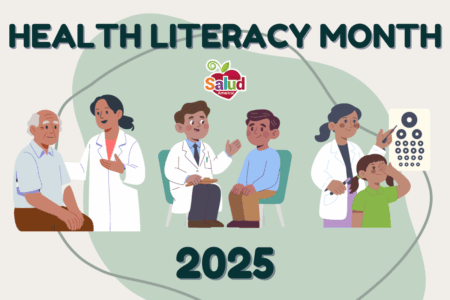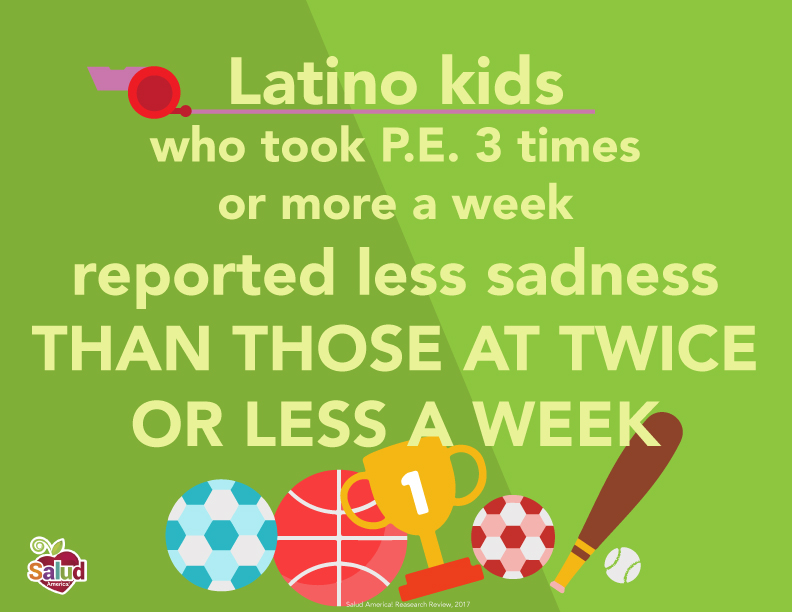
Share On Social!
This is part of our Mental Health & Latino Kids: A Research Review »
Physical activity is linked to mental health
Several studies have demonstrated a positive relationship between physical activity and mental health among Latino children.
The converse is also true.
Jernigan, et al., in a study of preadolescents (46.8% Latino), found that greater negative emotional symptoms at the baseline interview predicted a significantly increased BMI at a 2-year follow-up for Latino students (p=.03).45
In a cross-sectional review of data from the Healthy Youth/Healthy Adults study, which included 1,870 Latino and non-Latino white adolescents (77% were Latino) ages 14-18 from Nueces County, Tex., Brosnahan et al. investigated whether there was a relationship between physical activity and mental health among Latino high schoolers.
Participants completed a survey that included questions about the frequency and type of physical activity they engaged in, including sports teams and physical education classes, and questions related to experiencing feelings of sadness or suicidal thoughts.
Latino girls were found to be much less likely than their white peers to engage in moderate physical activity (p<.001), and they were also less likely to participate in team sports (p<.01); they were more likely, however, to report depressive symptoms (p=.08).
Overall, students who reported participating in physical education classes three-to-five days a week were less likely to report feeling sad or hopeless than were those who participated two or fewer days per week, and those who reported participating in at least six sessions of physical activity a week were significantly less likely to report having suicidal thoughts.46
Using semi-structured interviews and physical activity checklists, Grieser et al. identified attitudes toward physical activity as reported by Latino girls ages 11-13 from six middle schools in the U.S.
Over half of the participants stated a primary reason for participating in physical activity was to “stay in shape,” and 43 percent of participants also included socialization and being a part of a team as benefits to participation.
Latino girls were more likely than white and African American girls to participate in playing catch and walking for exercise; 31 percent of Latino girls stated that swimming was their favorite way to engage in physical activity, and many also reported enjoying dance, rollerblading, and soccer.
When asked what factors would prevent them from participating in physical activity, the participants identified fear of injury, sweating, and physical discomfort as reasons for abstaining.47
Sports interventions boost activity, mental health
Melnyk, et al., conducted a pilot study of 19 Latino adolescents who were enrolled in one of two health classes at a predominantly Latino high school in the Southwestern U.S.
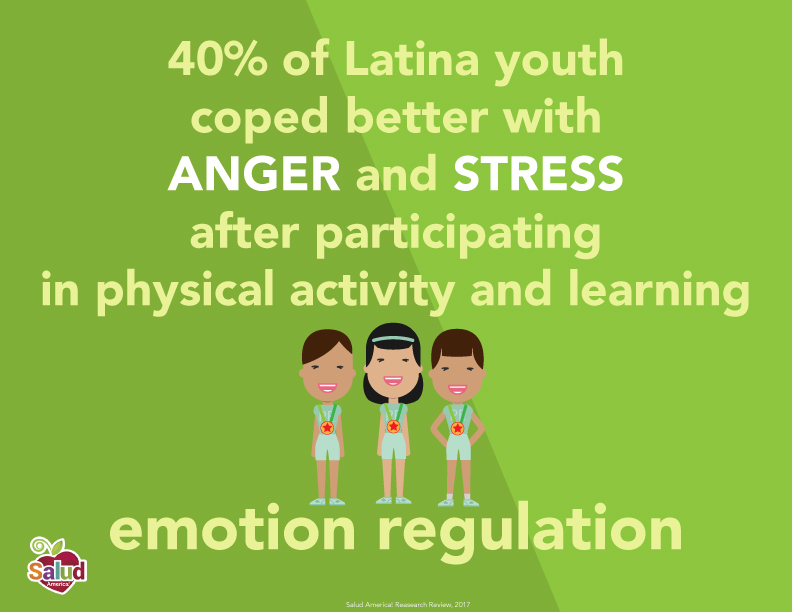 The pilot intervention, Creating Opportunities for Personal Empowerment (COPE) Healthy Lifestyles TEEN (Thinking, Emotions, Exercise, and Nutrition), used Cognitive Behavioral Therapy (CBT) throughout the 15 sessions, and was designed to present educational information about living a healthy lifestyle while engaging in practice and role playing to set goals, solve problems, and effectively regulate emotion and behavior. Questionnaires regarding nutrition, healthy lifestyle choices, and emotional and behavioral symptoms were administered at the outset of the intervention and following its conclusion.
The pilot intervention, Creating Opportunities for Personal Empowerment (COPE) Healthy Lifestyles TEEN (Thinking, Emotions, Exercise, and Nutrition), used Cognitive Behavioral Therapy (CBT) throughout the 15 sessions, and was designed to present educational information about living a healthy lifestyle while engaging in practice and role playing to set goals, solve problems, and effectively regulate emotion and behavior. Questionnaires regarding nutrition, healthy lifestyle choices, and emotional and behavioral symptoms were administered at the outset of the intervention and following its conclusion.
Post-intervention, 40 percent of the participants felt that they learned to better cope with feelings of stress and anger, and were better able to relax and manage their problems constructively.48
A study of 66 Latino 4th graders (33 male and 33 female) from low-income school districts found that, compared to a control group, those who participated in three 20-minute sessions of aerobic activity per week reported greater self-esteem, and they also reported reduced levels of depression after the intervention (p<.05).
The aerobic exercise group engaged in stationary cycling, track running, or jumping on a mini-trampoline to achieve a mean training heart rate of 160 bpm for the duration of the activity, while the control group engaged in walking or foursquare to maintain a mean heart rate of 134 bpm.49
Community-based interventions improve mental health access
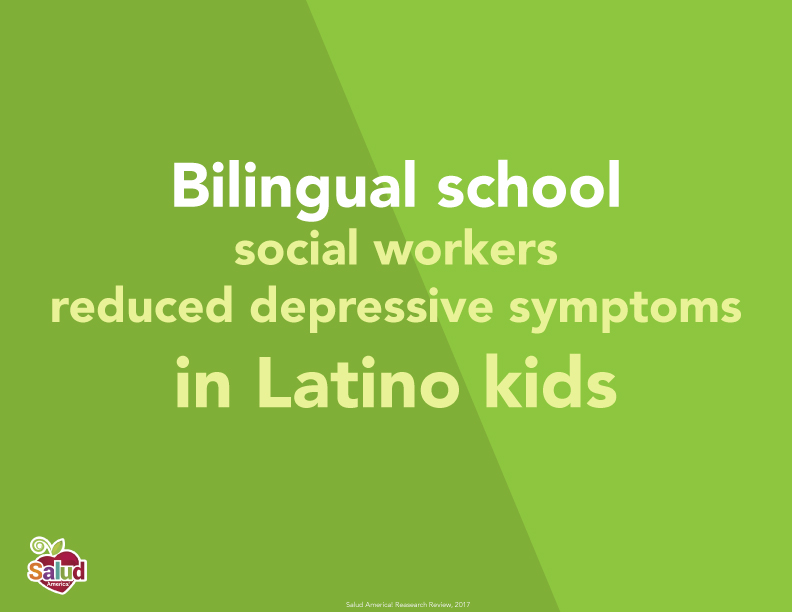 In a 2003 study, Kataoka et al., created a small-group CBT-based pilot intervention for 198 Latino immigrant students in grades 3-9 with PTSD or trauma-related depression. The intervention consisted of eight sessions led by bilingual school social workers with didactic presentations, cartoons, games, and individual worksheets for 152 participants (with 46 placed on a waitlist).
In a 2003 study, Kataoka et al., created a small-group CBT-based pilot intervention for 198 Latino immigrant students in grades 3-9 with PTSD or trauma-related depression. The intervention consisted of eight sessions led by bilingual school social workers with didactic presentations, cartoons, games, and individual worksheets for 152 participants (with 46 placed on a waitlist).
Almost all participants had clinical PTSD, one-third had PTSD with depressive symptoms, and 10 percent had depressive symptoms only. Sixty-nine percent of the students reported having been exposed to knife and/or gun violence.
In the intervention group, depressive symptoms were significantly decreased (p<.001); there was no change in the mean depressive symptom score in the waitlist group (p>.05).
A similarly significant decrease in PTSD symptoms was seen in the intervention group (p<.001) than among the waitlist group (p>.05).50
Community intervention: Puentes
Dumka et al. created the Puentes program, a culturally responsive, family-based training program to help prevent school disengagement and mental health problems in Mexican-American 7th graders.
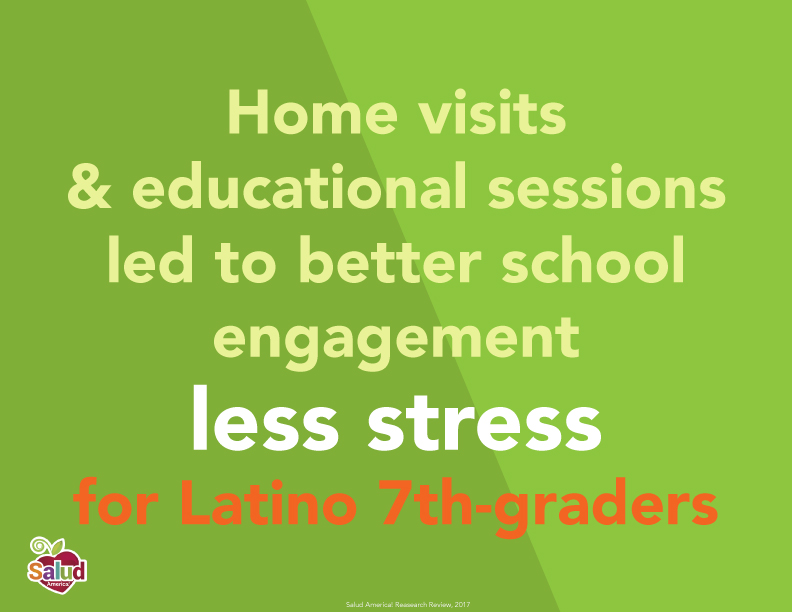 The study included 516 Mexican-American families and spanned three academic school years. The program included two home visits and nine weekly sessions, which included parent and teen, family interaction, and school liaison components. A single evening discussion group of parents and teens served as the control group. A school advisory board was created to include a school administrator or teacher, a parent representative from the school, a Puentes program co-investigator, and the Puentes project director. School liaisons were appointed to facilitate parent-school communication.51
The study included 516 Mexican-American families and spanned three academic school years. The program included two home visits and nine weekly sessions, which included parent and teen, family interaction, and school liaison components. A single evening discussion group of parents and teens served as the control group. A school advisory board was created to include a school administrator or teacher, a parent representative from the school, a Puentes program co-investigator, and the Puentes project director. School liaisons were appointed to facilitate parent-school communication.51
A follow-up study examined the effects of the Puentes program on school engagement 2 years after the intervention, when students were in the 9th grade, and examined the mediating effects of the intervention 5 years later, when students were in the 12th grade. Follow-up study measures included school engagement, internalizing and externalizing behaviors, substance use disorder, GPA, and high school dropout.
Higher levels of school engagement were found in the intervention group, which led to lower rates of high school dropout, internalizing symptoms, and substance use disorder.52
Community intervention: EDIPPP
The Early Detection, Intervention, and Prevention of Psychosis Program (EDIPPP) is a research initiative that included a national multisite treatment study.
The study evaluated an intervention for young people with a high risk of psychosis or those in the first 30 days of their first psychotic episode. The EDIPPP based the intervention on a community education and referral module that was initially created by the Portland Identification and Early Response (PIER) program.
The intervention involved the creation of a network of mental health professionals and community members who were educated to recognize the early signs of psychosis, including paranoid thoughts and suspiciousness, social withdrawal, and cognitive changes; intervention outreach included formal presentations, health fairs, and conferences.
The goal of the intervention was to generate rapid referrals of children at high risk of developing psychosis. Six sites were included in the EDIPPP test intervention: Portland, Maine; Salem, Ore.; Ypsilanti, Mich.; Queens, N.Y.; Sacramento, Calif.; and Albuquerque, N.M.
The study required that the child and one parent be proficient in English, and this was found to be a challenge at sites with large Latino populations.
However, overall, 14 percent of the referrals generated were for Latino youth, which was representative of the Latino population at most sites.53
Community intervention: Preschool-aged Latino kids
A mental health intervention specific to preschool-aged Latino children has been developed and is currently in the pilot testing phase.
Ginossar and Nelson developed this e-health intervention to address the mental health needs of Latino preschool children living in low-income communities in a border state.
The authors recruited six Mexican immigrant women from a computer training class at a community-based pediatric health clinic and trained them to be promotoras (Latino community members trained to provide basic health information).
The promotoras developed a website with an interactive component using their prior knowledge from the computer training class.
The website educational modules included information regarding the importance of addressing mental health problems at a young age, the identification of symptoms indicative of mental health problems, common mental health problems among children, treatment for different mental health problems, and local mental health services and resources.
After developing the intervention, the authors aimed to recruit 100 participants through flyers distributed in the community; those recruited will participate in five training sessions led by promotoras.54
More from our Mental Health & Latino Kids: A Research Review »
- Introduction & Methods
- Key Research Finding: Issues facing Latino kids
- Key Research Finding: Latino kids access to care
- Key Research Finding: The migration experience
- Key Research Finding: Latino family issues
- Key Research Finding: Latino community and school issues
- Key Research Finding: Programs with promise (this section)
- Key Research Finding: Policies with promise
- Policy Implications
- Future Research Needs
References for this section »
45. Jernigan, M. M. et al. Emotional Health Predicts Changes in Body Mass Index (BMI-z) Among Black and Latino Youth. Clin. Pediatr. (Phila.) 54, 693–696 (2015).
46. Brosnahan, J., Steffen, L. M., Lytle, L., Patterson, J. & Boostrom, A. The Relation Between Physical Activity and Mental Health Among Hispanic and Non-Hispanic White Adolescents. Arch. Pediatr. Adolesc. Med. 158, 818–823 (2004).
47. Grieser, M. et al. Physical Activity Attitudes, Preferences, and Practices in African American, Hispanic, and Caucasian Girls. Health Educ. Behav. Off. Publ. Soc. Public Health Educ. 33, 40–51 (2006).
48. Melnyk, B. M. et al. Improving the Mental Health, Healthy Lifestyle Choices, and Physical Health of Hispanic Adolescents: A Randomized Controlled Pilot Study. J. Sch. Health 79, 575–584 (2009).
49. Crews, D. J., Lochbaum, M. R. & Landers, D. M. Aerobic physical activity effects on psychological well-being in low-income Hispanic children. Percept. Mot. Skills 98, 319–324 (2004).
50. Kataoka, S. H. et al. A School-Based Mental Health Program for Traumatized Latino Immigrant Children. J. Am. Acad. Child Adolesc. Psychiatry 42, 311–318 (2003).
51. Dumka, L. E., Mauricio, A.-M. & Gonzales, N. A. Research Partnerships with Schools to Implement Prevention Programs for Mexican Origin Families. J. Prim. Prev. 28, 403–420 (2007).
52. Gonzales, N. A. et al. School Engagement Mediates Long-Term Prevention Effects for Mexican American Adolescents. Prev. Sci. 15, 929–939 (2014).
53. Lynch, S. et al. Early Detection, Intervention and Prevention of Psychosis Program: Community Outreach and Early Identification at Six U.S. Sites. Psychiatr. Serv. 67, 510–516 (2016).
54. Ginossar, T. & Nelson, S. Reducing the Health and Digital Divides: A Model for Using Community-Based Participatory Research Approach to E-Health Interventions in Low-Income Hispanic Communities. J. Comput.-Mediat. Commun. 15, 530–551 (2010).
Explore More:
Healthy Families & SchoolsBy The Numbers
142
Percent
Expected rise in Latino cancer cases in coming years

